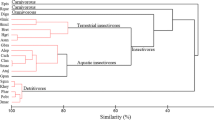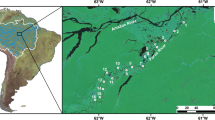The important contribution of terrestrial invertebrates to the energy budget of drift-foraging fishes has been well documented in many forested headwater streams. However, relatively little attention has been focused on the behavioral mechanisms behind such intensive exploitation. We tested for the hypothesis that active prey selection by fishes would be an important determinant of terrestrial invertebrates contribution to fish diets in a forested headwater stream in northern Japan. Rainbow trout, Oncorhynchus mykiss, were estimated to consume 57.12 mg m−2 day−1 (dry mass) terrestrial invertebrates, 77% of their total input (73.89 mg m−2 day−1), there being high selectivity for the former from stream drift. Both the falling input and drift of terrestrial invertebrates peaked at around dusk, decreasing dramatically toward midnight. In contrast, both aquatic insect adults and benthic invertebrates showed pronounced nocturnal drift. Because the prey consumption rates of rainbow trout were high at dawn and dusk, decreasing around midnight, the greater contribution of terrestrial invertebrates to trout diet was regarded as being partly influenced by the difference in diel periodicity of availability among prey categories. In addition, selectivity also depended upon differences in individual prey size among aquatic insect adults, and benthic and terrestrial invertebrates, the last category being largest in both the stream drift and the trout diets. We concluded that differences in both the timing of supplies and prey size among the three prey categories were the primary factors behind the selective foraging on terrestrial invertebrates by rainbow trout.
Similar content being viewed by others
REFERENCES
Abrams P. A. (1996) Dynamics and interactions in food webs with adaptive foragers. In: Food Webs (eds G. A. Polis & K. O. Winemiller) pp. 113–121. Chapman & Hall, New York.
Allan J. D. (1978) Trout predation and the size-composition of stream drift. Limnology and Oceanography 23: 1231–1237.
Allan J. D. (1981) Determinants of diet of brook trout (Salvelinus fontinalis) in a mountain stream. Canadian Journal of Fisheries and Aquatic Sciences 38: 184–192.
Allan J. D. (1983) Predator-prey relationships in streams. In: Stream Ecology: Application and Testing of Ecological Theory (eds J. R. Barnes & G. W. Minshall) pp. 191–229. Plenum Press, New York.
Allan J. D. (1995) Stream Ecology. Structure and Function of Running Waters. Chapman & Hall, New York.
Allen K. R. (1951) The Horokiwi stream: A study of a trout population. Bulletin of New Zealand Department of Fishery 10: 1–231.
Angradi T. R. & Griffith J. S. (1990) Diel feeding chronology and diet selection of rainbow trout (Oncorhynchus mykiss) in the Henry’s Fork of the Snake River, Idaho. Canadian Journal of Fisheries and Aquatic Sciences 47: 199–209.
Bisson P. A. (1978) Diel food selection by two sizes of rainbow trout (Salmo gairdneri) in an experimental stream. Journal of the Fisheries Research Board of Canada 35: 971–975.
Bjornn T. C. & Reiser D. W. (1991) Habitat requirements of salmonids in streams. In: Influences of Forest and Rangeland Management on Salmonid Fishes and Their Habitat (ed. W. R. Meehan) pp. 83–138. American Fisheries Society Special Publication 19, Bethesda, MD.
Chesson P. L. (1978) Measuring preference in selective predation. Ecology 59: 211–215.
Cloe W. W. & Garman G. C. (1996) The energetic importance of terrestrial arthropod inputs to three warm-water streams. Freshwater Biology 36: 105–114.
Cummins K. W., Cushing C. E., Minshall G. W. (1995) Introduction: an overview of stream ecosystems. In: River and Stream Ecosystems (eds C. E. Cushing K. W. Cummins & G. W. Minshall) pp. 1–8. Elsevier, New York.
Edwards E. D. & Huryn A. D. (1996) Effect of riparian land use on contributions of terrestrial invertebrates to streams. Hydrobiologia 337: 151–159.
Elliott J. M. (1972) Rates of gastric evacuation in brown trout, Salmo trutta L. Freshwater Biology 2: 1–18.
Elliott J. M. & Persson L. (1978) The estimation of daily rates of food consumption for fish. Journal of Animal Ecology 47: 977–991.
Forrester G. E., Chase J. G., McCarthy W. (1994) Diel and density-related changes in food consumption and prey selection by brook charr in a New Hampshire stream. Environmental Biology of Fishes 39: 301–311.
Furukawa-Tanaka T. (1985) The ecology of salmonid fishes in Japanese mountain streams. Japanese Journal of Ecology 35: 481–504.
Furukawa-Tanaka T. (1992) Optimal feeding position of stream fishes in relation to invertebrates drift. Humans and Nature 1: 63–81.
Garman G. C. (1991) Use of terrestrial arthropod prey by a stream-dwelling cyprinid fish. Environmental Biology of Fishes 30: 325–331.
Garman G. C. & Moring J. R. (1992) Diet and annual production of two boreal river fishes following clearcut logging. Environmental Biology of Fishes 36: 301–311.
Giles N. (1980) A stomach sampler for use on live fish. Journal of Fish Biology 16: 253–261.
Grant J. W. A. & Noakes D. L. G. (1986) A test of a size-selective predation model with juvenile brook charr, Salvelinus fontinalis. Journal of Fish Biology 29 (Suppl. A): 15–23.
Harper F., Magnin E., Harper P. P. (1983) Diel periodicity of emerging mayflies (Insecta: Ephemeroptera) in a Laurentian stream. Aquatic Insects 5: 21–31.
Hughes R. N. (1997) Diet selection. In: Behavioural Ecology of Teleost Fishes (ed. J-G. J. Godin) pp. 134–162. Oxford University Press, Oxford.
Hughes R. N. & Croy M. I. (1993) An experimental analysis of frequency-dependent predation (switching) in the 15-spined stickleback, Spinachia spinachia. Journal of Animal Ecology 62: 341–352.
Hunt R. L. (1975) Use of terrestrial invertebrates as food by salmonids. In: Coupling of Land and Water Systems (ed. A. D. Hasler) pp. 137–152. Springer-Verlag, New York.
Hynes H. B. N. (1970) The Ecology of Running Waters. University of Toronto Press, Toronto.
Irvine J. R. & Northcote T. G. (1983) Selection by young rainbow trout (Salmo gairdneri) in simulated stream environments for live and dead prey of different sizes. Canadian Journal of Fisheries and Aquatic Sciences 40: 1745–1749.
Kitano S., Nakano S., Inoue M., Shimoda K., Yamamoto S. (1993) Feeding and reproductive ecology of exotic rainbow trout Oncorhynchus mykiss in the Horonai Stream in Hokkaido, northern Japan. Nippon Suisan Gakkaishi 59: 1837–1843 (in Japanese with English summary).
Mason C. F. & MacDonald S. M. (1982) The input of terrestrial invertebrates from tree canopies to a stream. Freshwater Biology 12: 305–311.
Minshall G. W. (1967) Role of allochthonous detritus in the trophic structure of a woodland springbrook community. Ecology 48: 139–149.
Miyasaka H. & Nakano S. (1999) Effects of drift- and benthic-foraging fish on the drift dispersal of three species of mayfly nymphs in a Japanese stream. Oecologia 118: 106.
Nagasaka Y., Yanai S., Sato H. (1996) Relation between fallen insects from riparian forest and stomach content of masu salmon (Oncorhynchus masou). Bulletin of the Hokkaido Forestry Research Institute 33: 70–77.
Naiman R. J. & Décamps H. (1997) The ecology of interfaces: riparian zones. Annual Review of Ecology and Systematics 28: 621–665.
Nakano S. (1995) Individual differences in resource use, growth and emigration under the influence of a dominance hierarchy in fluvial red-spotted masu salmon in a natural habitat. Journal of Animal Ecology 64: 75–84.
Nakano S., Fausch K. D., Kitano S. (1999a) Flexible niche partitioning via a foraging mode shift: A proposed mechanisms for coexistence in stream-dwelling charrs. Journal of Animal Ecology (in press).
Nakano S. & T. Furukawa-Tanaka (1994) Intra- and interspecific dominance hierarchies and variation in foraging tactics of two species of stream-dwelling chars. Ecological Research 9: 9–20.
Nakano S., Miyasaka H., Kuhara N. (1999b) Terrestrial-aquatic linkages: riparian arthropod inputs alter trophic cascades in a stream food web. Ecology (in press).
Persson L., Diehl S., Eklöv P., Christensen B. (1997) Flexibility in fish behaviour: consequences at the population and community levels. In: Behavioural Ecology of Teleost Fishes (ed. J-G. J. Godin) pp. 134–162. Oxford University Press, Oxford.
Ringler N. H. (1979) Selective predation by drift feeding brown trout (Salmo trutta). Journal of the Fisheries Research Board of Canada 36: 392–403.
Robinson R. W. & Tash J. C. (1979) Feeding by Arizona trout (Salmo apache) and brown trout (Salmo trutta) at different light intensities. Environmental Biology of Fishes 4: 368.
Sagar P. M. & Glova G. J. (1988) Diel feeding periodicity, daily ration and prey selection of a riverine population of juvenile chinook salmon, Oncorhynchus tshawytscha (Walbaum). Journal of Fish Biology 33: 643–653.
Southwood T. R. E. (1961) The number of species of insect associated with various trees. Journal of Animal Ecology 30: 1–8.
Stephens D. W. & Krebs J. R. (1986) Foraging Theory. Princeton University Press, Princeton.
Tanida K., Yamashita K., Rossiter A. (1985) A portable current meter for field use. Japanese Journal of Limnology 46: 219–221.
Urabe H. & Nakano S. (1998) Contribution of woody debris to trout habitat modification in small streams in secondary deciduous forest, northern Japan. Ecological Research 13: 335–345.
Vannote R. L., Minshall G. W., Cummins K. W., Sedell J. R., Cushing C. E. (1980) The river continuum concept. Canadian Journal of Fisheries and Aquatic Sciences 37: 137.
Wallace J. B., Eggert S. L., Meyer J. L., Webster J. R. (1997) Multiple trophic levels of a forest stream linked to terrestrial litter inputs. Science 277: 102–104.
Waters T. F. (1972) The drift of stream insects. Annual Review of Entomology 17: 253–272.
Waters T. F. (1988) Fish production-benthos production relationships in trout streams. Polskie Archiwum Hydrobiologii 35: 545–561.
Waters T. F. (1993) Dynamics in stream ecology. Canadian Special Publication of Fisheries and Aquatic Sciences 118: 1–8.
Wipfli M. S. (1997) Terrestrial invertebrates as salmonid prey and nitrogen sources in streams: Contrasting old-growth and young-growth riparian forests in southeastern Alaska, U.S.A. Canadian Journal of Fisheries and Aquatic Sciences 54: 1259–1269.
Author information
Authors and Affiliations
Corresponding author
About this article
Cite this article
Nakano, S., Kawaguchi, Y., Taniguchi, Y. et al. Selective foraging on terrestrial invertebrates by rainbow trout in a forested headwater stream in northern Japan. Ecol Res 14, 351–360 (1999). https://doi.org/10.1046/j.1440-1703.1999.00315.x
Received:
Accepted:
Issue Date:
DOI: https://doi.org/10.1046/j.1440-1703.1999.00315.x




